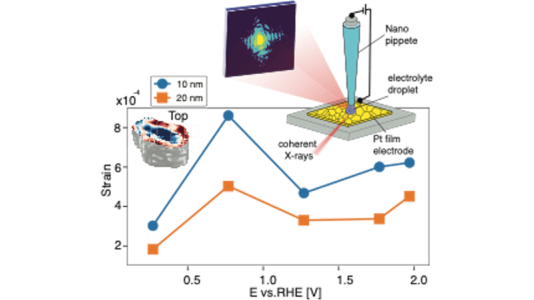
Scientific Achievement
In-situ Pt nanograin imaging revealed the evolution of a surface tensile strain in response to the electrochemical double layers by enhancing the stability of surface oxide at the potentials relevant to oxygen-evolution reactions.
Significance and Impact
Combining a nanopipette electrochemical cell with Bragg Coherent Diffraction Imaging, which enabled this discovery, opens new scanning capabilities for grain-by-grain strain images of real-world electrochemical surfaces.
Research Details
- A scanning-capable nanopipette electrochemical cell was developed to interface with coherent Bragg x-ray diffraction.
- Strain fields of Pt grains were imaged by Bragg coherent diffraction under electrochemical potentials relevant to surface-oxidation and oxygen-evolution reactions.
- Models were developed to explain the strain behavior using the known characteristics of electrochemical double layers.
Argonne National Laboratory seeks solutions to pressing national problems in science and technology. The nation’s first national laboratory, Argonne conducts leading-edge basic and applied scientific research in virtually every scientific discipline. Argonne researchers work closely with researchers from hundreds of companies, universities, and federal, state and municipal agencies to help them solve their specific problems, advance America’s scientific leadership and prepare the nation for a better future. With employees from more than 60 nations, Argonne is managed by UChicago Argonne, LLC for the U.S. Department of Energy’s Office of Science.
The U.S. Department of Energy’s Office of Science is the single largest supporter of basic research in the physical sciences in the United States and is working to address some of the most pressing challenges of our time. For more information, visit https://energy.gov/science.